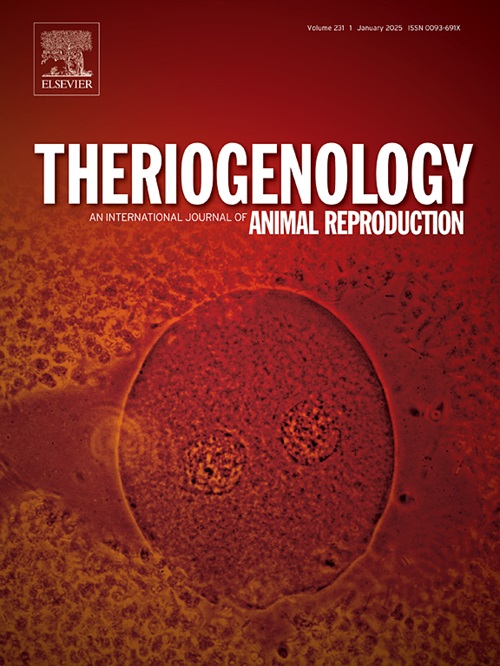Uterine disease in dairy cows is associated with contemporaneous perturbations to ovarian function
IF 2.4
2区 农林科学
Q3 REPRODUCTIVE BIOLOGY
引用次数: 0
Abstract
Postpartum uterine disease in dairy cows affects ovarian function, but it is unclear how the type and timing of disease relates to ovarian function. To explore associations between uterine disease and contemporaneous ovarian function, postpartum uterine health was evaluated in 17 lactating primiparous Holstein cows that ovulated. Ovarian function was assessed by measuring daily hormone concentrations and the diameter of the largest follicle and subsequent corpus luteum. Metritis (≤14 d postpartum) was associated with reduced follicle diameter (P = 0.002) and tended to reduce plasma estradiol concentrations (P = 0.062) from d 7 to 16 postpartum compared to cows without metritis. Metritis was associated with reduced plasma progesterone (P = 0.026) but not corpus luteum diameter from d 17 to 26 postpartum. Endometritis (≥15 d postpartum) was associated with reduced corpus luteum diameter (P = 0.005) but did not alter plasma progesterone from d 17 to 26 postpartum compared to cows without endometritis. To explore longer term effects of uterine infection on luteal function, non-lactating primiparous Holstein cows received an intrauterine infusion of vehicle control (n = 11) or pathogenic Escherichia coli and Trueperella pyogenes to induce endometritis (n = 12) and corpora lutea were recovered on d 16 of the estrous cycle, 146 d after intrauterine infusion. Intrauterine infusion of bacteria had no effect on plasma progesterone or luteal diameter compared to control, and only altered the expression of 2 of 94 candidate genes (NCF1 and TLR9). Taken together, these studies imply that uterine diseases are principally associated with changes to ovarian function at a time contemporaneous with disease.
奶牛子宫疾病与同期卵巢功能紊乱有关。
奶牛产后子宫疾病会影响卵巢功能,但目前还不清楚疾病的类型和时间与卵巢功能的关系。为了探索子宫疾病与同期卵巢功能之间的关系,我们对17头泌乳期排卵的初产荷斯坦奶牛的产后子宫健康状况进行了评估。卵巢功能是通过测量每日激素浓度、最大卵泡直径和随后的黄体来评估的。与未患子宫内膜炎的奶牛相比,子宫内膜炎(产后≤14 d)与卵泡直径减小有关(P = 0.002),并且产后第7至16 d血浆雌二醇浓度有降低的趋势(P = 0.062)。从产后第 17 天到第 26 天,子宫内膜炎与血浆孕酮降低有关 (P = 0.026),但与黄体直径无关。子宫内膜炎(产后≥15 d)与黄体直径减小有关(P = 0.005),但与未患子宫内膜炎的奶牛相比,血浆孕酮在产后 17 至 26 d 不会发生变化。为了探究子宫感染对黄体功能的长期影响,非哺乳初产荷斯坦奶牛接受了宫腔内输注载体对照(n = 11)或致病性大肠杆菌和化脓性真菌诱导的子宫内膜炎(n = 12),并在发情周期的第 16 天,即宫腔内输注 146 天后恢复黄体。与对照组相比,宫腔内灌注细菌对血浆孕酮或黄体直径没有影响,而且只改变了 94 个候选基因中 2 个基因(NCF1 和 TLR9)的表达。综上所述,这些研究表明,子宫疾病主要与卵巢功能的变化有关,而卵巢功能的变化则与疾病同时发生。
本文章由计算机程序翻译,如有差异,请以英文原文为准。
求助全文
约1分钟内获得全文
求助全文
来源期刊

Theriogenology
农林科学-生殖生物学
CiteScore
5.50
自引率
14.30%
发文量
387
审稿时长
72 days
期刊介绍:
Theriogenology provides an international forum for researchers, clinicians, and industry professionals in animal reproductive biology. This acclaimed journal publishes articles on a wide range of topics in reproductive and developmental biology, of domestic mammal, avian, and aquatic species as well as wild species which are the object of veterinary care in research or conservation programs.
 求助内容:
求助内容: 应助结果提醒方式:
应助结果提醒方式:


